4.1. SciPy tutorial#
SciPy is the core library for scientific computing in Python. It provides many user-friendly and efficient numerical routines, such as numerical integration, interpolation, optimization, linear algebra, and statistics. These routines are composed as task-specific subpackages in SciPy, such as scipy.cluster for vector quantization/ Kmeans, scipy.linalg for linear algebra routines. All SciPy subpackages depend on NumPy, but are mostly independent of each other.
scipy.stats module contains a large number of summary and frequency statistics, probability distributions, correlation functions, statistical tests, kernel density estimation, quasi-Monte Carlo functionality, and so on.
In this tutorial, we will cover:
scipy.stats: Statistics, Distributions, Statistical Tests and CorrelationsExtreme Value Analysis
The standard way of importing NumPy and one SciPy sub-package is:
import numpy as np
from scipy import stats
print(stats.__name__)
scipy.stats
4.1.1. Descriptive Statistics#
When we have a new dataset in hand, we need to have a descriptive or summary view of the data. This could normally be done through two main approaches:
The quantitative approach describes and summarizes data numerically using statistics. We focus on this approach in this
scipy.statstutorial.The visual approach illustrates data with charts, plots, histograms, and other graphs. This approach is covered in the tutorial of
matplotlib.
There are multiple ways to obtain descriptive statistics of the dataset in Python. Note that SciPy is established based on NumPy and it offers additional functionality compared to NumPy. Common statistics already exist in NumPy (such as mean, median, var).
A = np.array([[10, 14, 11, 7, 9.5], [8, 9, 17, 14.5, 12],
[15, 7, 11.5, 10, 10.5], [11, 11, 9, 12, 14]])
print(A)
# Mean (Location Parameter)
print("Mean: ", np.mean(A, axis=0))
# Median (Location Parameter)
print("Median: ", np.median(A, axis=0))
# Variance (Scale Parameter)
print("Variance: ", np.var(A, axis=0, ddof=1)) #ddof=1 provides an unbiased estimator of the variance
[[10. 14. 11. 7. 9.5]
[ 8. 9. 17. 14.5 12. ]
[15. 7. 11.5 10. 10.5]
[11. 11. 9. 12. 14. ]]
Mean: [11. 10.25 12.125 10.875 11.5 ]
Median: [10.5 10. 11.25 11. 11.25]
Variance: [ 8.66666667 8.91666667 11.72916667 10.0625 3.83333333]
For more complicated statistics such as iqr, skew, kurtosis, we need to use scipy.stats.
# IQR (Scale Parameter)
print("IQR: ", stats.iqr(A, axis=0))
# Skewness (Shape Parameter)
print("Skewness: ", stats.skew(A, axis=0))
# Kurtosis (Shape Parameter)
print("Kurtosis: ", stats.kurtosis(A, axis=0, bias=False))
# You can also quickly get descriptive statistics with a single function
print("Descriptive statistics:\n", stats.describe(A, axis=0))
IQR: [2.5 3.25 2.375 3.375 2.25 ]
Skewness: [ 0.54309084 0.24394285 0.80172768 -0.11813453 0.34616807]
Kurtosis: [ 1.5 -0.41610621 2.53815357 -0.32082096 -0.768431 ]
Descriptive statistics:
DescribeResult(nobs=4, minmax=(array([8. , 7. , 9. , 7. , 9.5]), array([15. , 14. , 17. , 14.5, 14. ])), mean=array([11. , 10.25 , 12.125, 10.875, 11.5 ]), variance=array([ 8.66666667, 8.91666667, 11.72916667, 10.0625 , 3.83333333]), skewness=array([ 0.54309084, 0.24394285, 0.80172768, -0.11813453, 0.34616807]), kurtosis=array([-1. , -1.25548083, -0.86157952, -1.24277613, -1.30245747]))
As we often use pandas to handle data, we could use the Pandas function describe() to have an instant look at common statistics of the DataFrame (or Series). Next is an example of summarizing daily rainfall.
import pandas as pd
dr = pd.read_csv('../../assets/data/Changi_daily_rainfall.csv', index_col=0, header=0, parse_dates=True)
print(dr.head())
print(dr.describe())
Daily Rainfall Total (mm)
Date
1981-01-01 0.0
1981-01-02 0.0
1981-01-03 0.0
1981-01-04 0.0
1981-01-05 0.0
Daily Rainfall Total (mm)
count 14610.000000
mean 5.721629
std 14.194586
min 0.000000
25% 0.000000
50% 0.000000
75% 4.200000
max 216.200000
We could also get specific statistics by directly operating on the DataFrame. In this case, the unbiased estimator is used by default.
# Mean (Location Parameter)
print(dr.mean())
# Median (Location Parameter)
print(dr.median())
# Variance (Scale Parameter)
print(dr.var())
# Skewness (Shape Parameter)
print(dr.skew())
# Kurtosis (Shape Parameter)
print(dr.kurtosis())
Daily Rainfall Total (mm) 5.721629
dtype: float64
Daily Rainfall Total (mm) 0.0
dtype: float64
Daily Rainfall Total (mm) 201.486277
dtype: float64
Daily Rainfall Total (mm) 5.130516
dtype: float64
Daily Rainfall Total (mm) 40.832293
dtype: float64
4.1.2. Distributions#
scipy.stats contains a lot of objects for probability distributions, including continuous distributions and discrete distributions.
Continuous distributions
Some examples are norm (normal distribution), gamma (gamma distribution), uniform (uniform distribution). Each object of continuous distributions comes with many useful methods, such as its PDF (probability density function), its CDF (cumulative distribution function), and so on.
Normally, we would directly import specific distributions into Python for convenience. Next is the example of a normal distribution whose mean is 5 and standard deviation is 2.
from scipy.stats import norm
bins = np.arange(5 - 3 * 2, 5 + 3 * 2, 0.01)
PDF = norm.pdf(bins, loc=5, scale=2) # generate PDF in bins
CDF = norm.cdf(bins, loc=5, scale=2) # generate CDF in bins
SF = norm.sf(bins, loc=5, scale=2) # generate survival function (1-CDF)
PPF = norm.ppf(0.5, loc=5, scale=2) # obtain percent point (inverse of CDF)
RVS = norm.rvs(loc=5, scale=2, size=1000) # generate 1000 random variates
MMS = norm.stats(loc=5, scale=2, moments='mvsk') # obtain the four moments
import matplotlib.pyplot as plt
plt.plot(bins, PDF)
plt.ylabel("PDF")
plt.show()
plt.plot(bins, CDF)
plt.ylabel("CDF")
plt.show()
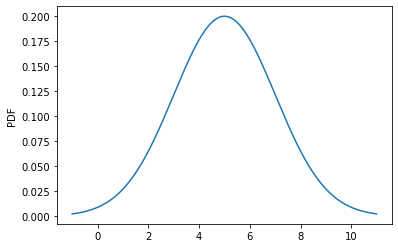
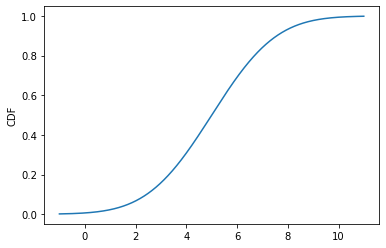
One common practice is to fit a dataset into a distribution. Next is an example.
samples = norm.rvs(loc=5, scale=2, size=1000) # pesudo dataset
mu, sigma = norm.fit(samples, method="MLE") # do a maximum-likelihood fit
print(mu, sigma)
# Plot figure
bins = np.arange(mu - 3 * sigma, mu + 3 * sigma, 0.01)
plt.hist(samples, density=True, histtype='stepfilled',
alpha=0.2, label='Samples')
plt.plot(bins, norm.pdf(bins, loc=mu, scale=sigma),
'k-', lw=2, label='Fit')
plt.legend(loc='best', frameon=False)
plt.show()
5.055650656764304 2.0756534192971463
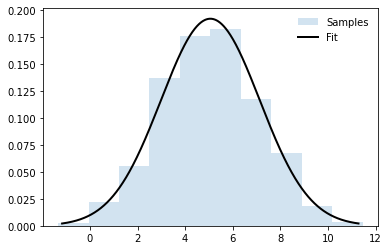
Note
The distribution objects in scipy.stats could be employed in two ways. The first is to input distribution parameters every time, as in the example above. The other way is to create a “frozen” distribution object by fixing the distribution parameters. For example, distr = norm(loc=5, scale=2). The example in the following section of discrete distributions employs this way.
Discrete distributions
Some examples are bernoulli (Bernoulli distribution), binom (binomial distribution), poisson (poisson distribution). Similarly, each object of discrete distributions comes with some useful methods, such as its PMF (probability mass function), its CDF (cumulative distribution function), and so on.
from scipy.stats import binom
n, p = 5, 0.4
distr = binom(n, p) # frozen distribution
x = np.arange(0, 5)
PMF = distr.pmf(x) # generate PMF in x
CDF = distr.cdf(x) # generate CDF in x
MMS = distr.stats(moments='mvsk') # obtain the four moments
RVS = distr.rvs(size=1000) # generate random variates
plt.plot(x, PMF, 'bo')
plt.vlines(x, 0, PMF, 'b', lw=1)
plt.ylabel("PMF")
plt.show()
plt.plot(x, CDF, 'bo')
plt.vlines(x, 0, CDF, 'b', lw=1)
plt.ylabel("CDF")
plt.show()
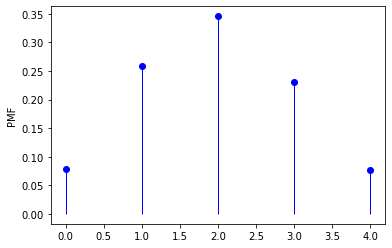
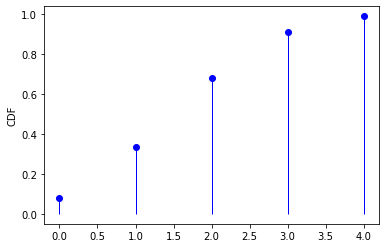
For a full list of probability distributions in scipy.stats, please refer to this official website.
4.1.3. Statistical Tests#
scipy.stats contains a lot of common statistical tests, such as ttest_ind (T-test for the means of two independent samples), kstest (Kolmogorov-Smirnov test for goodness of fit) and so on.
For instance, if we have two sets of observations that we assume are generated from Gaussian processes, we can use a T-test stats.ttest_ind to decide whether the means of two sets of observations are significantly different.
a = np.random.normal(0, 1, size=100) # Sample A
b = np.random.normal(1, 1, size=10) # Sample B
T, p = stats.ttest_ind(a, b) # T-test
print(T, p)
-3.3344152893762242 0.0011719701545575287
The resulting output in this case is composed of:
T statistic value: a number the sign of which is proportional to the difference between the two random processes and the magnitude is related to the significance of this difference.
p value: the probability of both processes being identical. If it is close to 1, the two processes are almost certainly identical. The closer it is to zero, the more likely it is that the processes have different means.
For a full list of supported statistical tests in scipy.stats, please refer to this official website.
4.1.4. Correlations#
scipy.stats contains some basic correlation functions, such as pearsonr (Pearson correlation coefficient), spearmanr (Spearman correlation coefficient), kendalltau (Kendall’s tau correlation measure). Next is an example of Kendall’s tau correlation for annual rainfall.
dr = pd.read_csv('../../assets/data/Changi_daily_rainfall.csv', index_col=0, header=0, parse_dates=True)
yr = dr.resample("Y", label="right").sum() # aggregate annual rainfall total
yr.index = yr.index.year
yr.columns = ["Yearly Rainfall Total (mm)"]
print(yr.head())
tau, p = stats.kendalltau(yr.index, yr)
# tau is Kendall’s tau measure and p is the corresponding p-value
print(tau, p)
Yearly Rainfall Total (mm)
Date
1981 1336.3
1982 1581.7
1983 1866.5
1984 2686.7
1985 1483.9
-0.0358974358974359 0.7442511261559122
For more advanced regression models, you may refer to statistical model package statsmodels or the machine learning package sklearn. A brief beginner guide of this could also be found in RealPython.
4.1.5. Extreme Value Analysis#
Extreme value analysis (EVA) is a process primarily to estimate the probability of events that are more extreme than any previously observed. It is widely applied in many fields such as engineering, meteorology, hydrology, finance, etc. For example, we could use EVA to estimate the probability distributions of extreme hydrological events and correspondingly estimate the magnitudes of extreme hydrological events under specific return periods.
In this section, we will take a time series of streamflow as an example to show the extreme value analysis for annual 5-day low-flow in Python step by step.
4.1.5.1. Extract extreme values#
We first load the daily streamflow data from the file using pandas and calculate the 5-day moving average of streamflow. Extreme events are collected from each year by picking the minimum 5-day low-flow.
# Load Data
ds = pd.read_csv('../../assets/data/Streamflow_02401390.dat', delimiter='\s+',
index_col=0, header=None, parse_dates=True)
ds.columns = ["Streamflow"]
ds.index.name = 'Date'
ds.head()
| Streamflow | |
|---|---|
| Date | |
| 1981-01-01 | 40.0 |
| 1981-01-02 | 39.0 |
| 1981-01-03 | 41.0 |
| 1981-01-04 | 39.0 |
| 1981-01-05 | 37.0 |
# Calculate 5-day flow
ds5day = ds.rolling(5, center=True).mean() # moving average
ds5day.columns = ["5-day flow"]
print(ds5day.head())
# Extract annual low-flow
lowf = ds5day.resample("Y").min() # yearly minimum
lowf.index = lowf.index.year
lowf.columns = ["Annual low-flow"]
print(lowf.head())
# Plot annual 5-day low-flow
plt.plot(lowf)
plt.xlabel("Year")
plt.ylabel("Low-flow ($m^3/s$)")
plt.show()
5-day flow
Date
1981-01-01 NaN
1981-01-02 NaN
1981-01-03 39.2
1981-01-04 38.4
1981-01-05 39.4
Annual low-flow
Date
1981 11.2
1982 19.2
1983 19.8
1984 17.6
1985 25.4
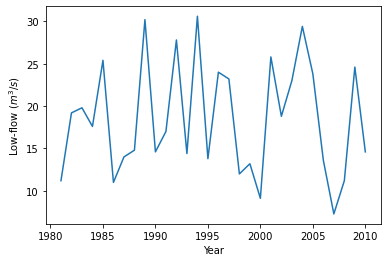
4.1.5.2. Fit distribution (parameter estimation)#
Next, we fit a distribution to the annual low-flow extreme events. Here, we assume that annual low-flow follows a generalized extreme value (GEV) distribution genextreme(c, loc=loc, scale=scale), which has three parameters: loc (location parameter), scale (scale parameter) and c (shape parameter).
from scipy.stats import genextreme as gev
Here, we introduce two methods to estimate the parameters, including the maximum likelihood method (MLE) and the method of L-moments.
Maximum likelihood method (MLE)
c0, loc0, scale0 = gev.fit(lowf, method="MLE")
print(loc0, scale0, c0)
MLEGEV = gev(c0, loc=loc0, scale=scale0) # Frozen distribution
15.808425716808408 5.941316015077605 0.16158787388446866
Method of L-moments (LMM)
In the context of EVA, observations tend to follow a distribution more complicated than the normal distribution. The method of L-moments is more recommended in this case compared to MLE (more details referred to WikiPedia). However, scipy.stats only includes the common MLE method and method of moments for parameter estimation. We need to code the method of L-moments on our own.
The L-moments are established based on the probability weighted moments. To be specific, they are linear combinations of probability weighted moments. The probability weighted moments are defined as
\( \begin{align} & \beta_0=\int_{0}^{1} F^{-1}(p)p^0\text{d}p\\ & \beta_1=\int_{0}^{1} F^{-1}(p)p^1\text{d}p \tag{1}\\ & \beta_2=\int_{0}^{1} F^{-1}(p)p^2\text{d}p\\ \end{align} \)
where \(x\) is the random variable of interest, \(F(x)\) is the cumulative distribution, and \(F^{-1}(p)\) is the inverse of cumulative distribution.
The basic idea of the method of L-moments is to use sample L-moments as the estimates of population L-moments. Then, if we could get the relationships between the population L-moments and the distribution parameters, we could get the estimates of parameters by plugging sample L-moments. In order to calculate L-moments of samples, we need to calculate probability weighted moments of samples at first. Assume a set of samples \(X_j\ (X_1>X_2>...>X_n)\), probability weighted moments of samples are
\( \begin{align} & b_0=\overline{X} \\ & b_1=\sum_{j=1}^{n-1} \frac{(n-j)X_j}{n(n-1)} \tag{2}\\ & b_2=\sum_{j=1}^{n-2} \frac{(n-j)(n-j-1)X_j}{n(n-1)(n-2)}\\ \end{align} \)
where \(b_0, b_1, b_2\) are the first three unbiased probability weighted moments of samples.
The relationship between the first three L-moments and probability weighted moments are
\( \begin{align} & \lambda_1=b_0\\ & \lambda_2=2b_1-b_0 \tag{3}\\ & \lambda_3=6b_2-6b_1+b_0\\ \end{align} \)
where \(\lambda_1, \lambda_2, \lambda_3\) are the first three L-moments. By plugging equation (2) into equation (3), we could obtain the sample L-moments.
# Calculate samples L-moments
def samlmom3(sample):
"""
samlmom3 returns the first three L-moments of samples
sample is the 1-d array
n is the total number of the samples, j is the j_th sample
"""
n = len(sample)
sample = np.sort(sample.reshape(n))[::-1]
b0 = np.mean(sample)
b1 = np.array([(n - j - 1) * sample[j] / n / (n - 1)
for j in range(n)]).sum()
b2 = np.array([(n - j - 1) * (n - j - 2) * sample[j] / n / (n - 1) / (n - 2)
for j in range(n - 1)]).sum()
lmom1 = b0
lmom2 = 2 * b1 - b0
lmom3 = 6 * (b2 - b1) + b0
return lmom1, lmom2, lmom3
LMM = samlmom3(lowf["Annual low-flow"].values)
print(LMM)
(18.5, 3.8837241379310328, 0.37207881773398555)
Hosking (1990; Table 1) has proven that for the GEV distribution, the relationships between the L-moments and distribution parameters are
\( \begin{align} \lambda_1 & =\mu+\sigma[1-\Gamma(1+\xi)]/\xi \\ \lambda_2 & =\sigma(1-2^{-\xi})\Gamma(1+\xi)/\xi \tag{4} \\ \frac{\lambda_3}{\lambda_2} & =\frac{2(1-3^{-\xi})}{1-2^{-\xi}}-3 \end{align} \)
where \(\mu, \sigma, \xi\) are respectively GEV’s location loc, scale scale, and shape c parameters. Obviously, there are no explicit solutions to these equations when we plugin the sample L-moments. Luckily, we could resort to the function solver scipy.optimize.fsolve in the optimization sub-package of SciPy to get numerical solutions.
# Estimate GEV parameters using the function solver
from scipy.optimize import fsolve
import math
def pargev_fsolve(lmom):
"""
pargev_fsolve estimates the parameters of the Generalized Extreme Value
distribution given the L-moments of samples
"""
lmom_ratios = [lmom[0], lmom[1], lmom[2] / lmom[1]]
f = lambda x, t: 2 * (1 - 3**(-x)) / (1 - 2**(-x)) - 3 - t
G = fsolve(f, 0.01, lmom_ratios[2])[0]
para3 = G
GAM = math.gamma(1 + G)
para2 = lmom_ratios[1] * G / (GAM * (1 - 2**-G))
para1 = lmom_ratios[0] - para2 * (1 - GAM) / G
return para1, para2, para3
loc1, scale1, c1 = pargev_fsolve(LMM)
print(loc1, scale1, c1)
15.587575273199434 6.18294944388195 0.11881321836725452
Alternatively, a numerical approximation method for the solution of equation (4) was proposed by Donaldson (1996).
# Estimate GEV parameters using numerical approximations
from scipy import special
import math
def pargev(lmom):
"""
pargev returns the parameters of the Generalized Extreme Value
distribution given the L-moments of samples
"""
lmom_ratios = [lmom[0], lmom[1], lmom[2]/lmom[1]]
SMALL = 1e-5
eps = 1e-6
maxit = 20
# EU IS EULER'S CONSTANT
EU = 0.57721566
DL2 = math.log(2)
DL3 = math.log(3)
# COEFFICIENTS OF RATIONAL-FUNCTION APPROXIMATIONS FOR XI
A0 = 0.28377530
A1 = -1.21096399
A2 = -2.50728214
A3 = -1.13455566
A4 = -0.07138022
B1 = 2.06189696
B2 = 1.31912239
B3 = 0.25077104
C1 = 1.59921491
C2 = -0.48832213
C3 = 0.01573152
D1 = -0.64363929
D2 = 0.08985247
T3 = lmom_ratios[2]
if lmom_ratios[1] <= 0 or abs(T3) >= 1:
raise ValueError("Invalid L-Moments")
if T3 <= 0:
G = (A0 + T3 * (A1 + T3 * (A2 + T3 * (A3 + T3 * A4)))) / (1 + T3 * (B1 + T3 * (B2 + T3 * B3)))
if T3 >= -0.8:
para3 = G
GAM = math.exp(special.gammaln(1 + G))
para2 = lmom_ratios[1] * G / (GAM * (1 - 2**-G))
para1 = lmom_ratios[0] - para2 * (1 - GAM) / G
return para1, para2, para3
elif T3 <= -0.97:
G = 1 - math.log(1 + T3) / DL2
T0 = (T3 + 3) * 0.5
for IT in range(1, maxit):
X2 = 2 ** -G
X3 = 3 ** -G
XX2 = 1 - X2
XX3 = 1 - X3
T = XX3 / XX2
DERIV = (XX2 * X3 * DL3 - XX3 * X2 * DL2) / (XX2**2)
GOLD = G
G -= (T - T0) / DERIV
if abs(G - GOLD) <= eps * G:
para3 = G
GAM = math.exp(special.gammaln(1 + G))
para2 = lmom_ratios[1] * G / (GAM * (1 - 2**-G))
para1 = lmom_ratios[0] - para2 * (1 - GAM) / G
return para1, para2, para3
raise Exception("Iteration has not converged")
else:
Z = 1 - T3
G = (-1 + Z * (C1 + Z * (C2 + Z * C3))) / (1 + Z * (D1 + Z * D2))
if abs(G) < SMALL:
para2 = lmom_ratios[1] / DL2
para1 = lmom_ratios[0] - EU * para2
para3 = 0
else:
para3 = G
GAM = math.exp(special.gammaln(1 + G))
para2 = lmom_ratios[1] * G / (GAM * (1 - 2**-G))
para1 = lmom_ratios[0] - para2 * (1 - GAM) / G
return para1, para2, para3
loc1, scale1, c1 = pargev(LMM)
print(loc1, scale1, c1)
LMMGEV = gev(c1, loc=loc1, scale=scale1) # Frozen distribution
15.587575475184854 6.182949767501039 0.11881328920002591
We could observe that both the function solver and numerical approximations generate almost the same results of distribution parameters.
4.1.5.3. Compare with empirical distribution#
Although we have obtained the estimated probability distribution of annual low-flow by parameter estimation, it is necessary to examine its performance in characterizing the observation datasets. Here, we first examine this by directly looking at the probability density function (PDF) and cumulative distribution function (CDF); then, we examine this through statistical inference.
Probability density function
# Plot empirical PDF
plt.hist(lowf, density=True, histtype='stepfilled',
alpha=0.2, label='Empirical PDF')
# Plot estimated PDF based on maximum likelihood method
bins = np.linspace(MLEGEV.ppf(0.01), MLEGEV.ppf(0.99), 100)
plt.plot(bins, MLEGEV.pdf(bins),
'r-', lw=2, label='Estimated PDF (MLE)')
# Plot estimated PDF based on the method of L-moments
bins = np.linspace(LMMGEV.ppf(0.01), LMMGEV.ppf(0.99), 100)
plt.plot(bins, LMMGEV.pdf(bins),
'b-', lw=2, label='Estimated PDF (LMM)')
plt.xlabel("Annual 5-day Low-flow ($m^3/s$)")
plt.legend(loc='best', frameon=False)
plt.show()
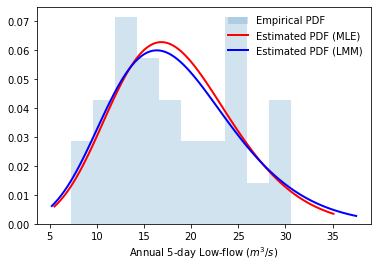
Cumulative distribution function
Since we are often more concerned about the rare cases of extreme events (which lay at the edge of PDF), it is also common practice to plot CDF to have a check.
# Plot empirical CDF
plt.scatter(lowf.sort_values(by = ["Annual low-flow"]),
np.arange(1, lowf.size+1, dtype=float)/lowf.size,
color = 'orangered', facecolors='none', label='Empirical CDF')
# Plot estimated PDF based on maximum likelihood method
bins = np.linspace(MLEGEV.ppf(0.01), MLEGEV.ppf(0.99), 100)
plt.plot(bins, MLEGEV.cdf(bins),
'r-', lw=2, label='Estimated CDF (MLE)')
# Plot estimated PDF based on the method of L-moments
bins = np.linspace(LMMGEV.ppf(0.01), LMMGEV.ppf(0.99), 100)
plt.plot(bins, LMMGEV.cdf(bins),
'b-', lw=2, label='Estimated CDF (LMM)')
plt.xlabel("Annual 5-day Low-flow ($m^3/s$)")
plt.legend(loc='best', frameon=False)
plt.show()
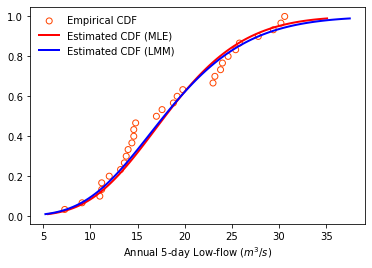
Statistical inference: Kolmogorov-Smirnov (KS) test
There are several tests available to test the performances of distribution fits. Here we used the Kolmogorov-Smirnov (KS) test, which is available in scipy.stats.kstest. This is a two-sided test for the null hypothesis that the distribution of independent samples is identical to the specified cumulative distribution. If the KS statistic is small or the p-value is high, then we cannot reject the hypothesis that samples follow the specified distribution.
MLEKS = stats.kstest(lowf["Annual low-flow"], MLEGEV.cdf)
print(MLEKS)
LMMKS = stats.kstest(lowf["Annual low-flow"], LMMGEV.cdf)
print(LMMKS)
KstestResult(statistic=0.16008786925974927, pvalue=0.3845846196401085)
KstestResult(statistic=0.14516854345180497, pvalue=0.5061871580723805)
4.1.5.4. Estimate extreme values for specific return periods#
One goal of EVA is to estimate the extreme values corresponding to some return periods. In the case of low-flow, the relationship between the non-exceedance probability and the return period is
where \(x_{T}\) is the extreme annual 5-day low-flow corresponding to the return period of \(T\).
# return periods from 2 years to 1000 years
T = np.arange(2, 1001)
# extreme low-flow under each return period
LFTmle = MLEGEV.ppf(1.0 / T)
LFTmle = pd.DataFrame(LFTmle, index=T, columns=["Annual 5-day low-flow"])
LFTmle.index.name = "Return period"
print(LFTmle.loc[[2, 5, 10, 100, 1000]])
LFTlmm = LMMGEV.ppf(1.0 / T)
LFTlmm = pd.DataFrame(LFTlmm, index=T, columns=["Annual 5-day low-flow"])
LFTlmm.index.name = "Return period"
print(LFTlmm.loc[[2, 5, 10, 100, 1000]])
# Plot low-flow vs return periods
plt.plot(LFTmle, 'r-', lw=2, label='MLE')
plt.plot(LFTlmm, 'b-', lw=2, label='LMM')
plt.xscale('log')
plt.ylabel('Annual 5-day low-flow ($m^3/s$)')
plt.xlabel('Return period (years)')
plt.legend(loc='best', frameon=False)
plt.show()
Annual 5-day low-flow
Return period
2 17.922767
5 12.869493
10 10.503747
100 5.517358
1000 2.330862
Annual 5-day low-flow
Return period
2 17.805074
5 12.560429
10 10.166638
100 5.234184
1000 2.154865
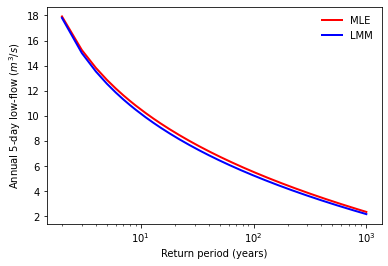
4.1.6. References#
This tutorial was edited based on Python Statistics Fundamentals, Scipy Lecture Notes, royalosyin’s guide to carry out EVA and OpenHydrology’s lmoments3 repository.
Only the
scipy.statssub-package is introduced here. If you wish to get a quick glimpse on other subpackages of SciPy, you could refer to scipy-lectures.
